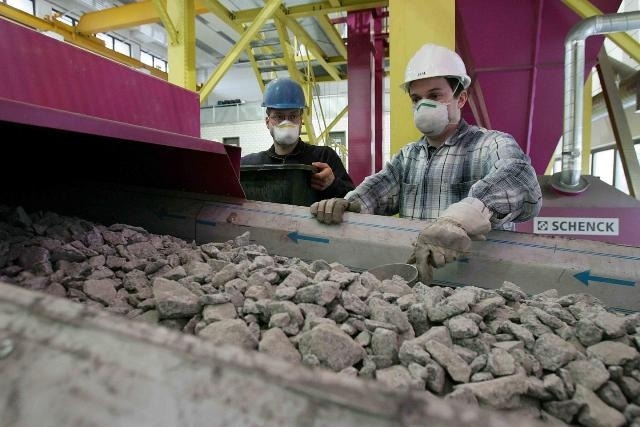Mar 22 2016
Researchers at the Helmholtz Institute Freiberg for Resource Technology (HIF) are developing a new strategy for processing the Vietnamese "Nam Xe" rare earth ore deposits in an environmentally friendly and economical manner. Optical sensors are to be employed for the first time in this endeavor.
The recently initiated project, in cooperation with the UVR-FIA GmbH, is part of the CLIENT funding measure. Through this measure, the German Federal Ministry of Education and Research fosters the cooperation with newly industrialized countries, thus supporting sustainable climate protection and environmental technologies as well as economic development.
 Separating non-valuable rock from the ore at the earliest possible stage minimizes costs and rubble in further processing of raw materials. Credit: TUBAF/Detlev Müller
Separating non-valuable rock from the ore at the earliest possible stage minimizes costs and rubble in further processing of raw materials. Credit: TUBAF/Detlev Müller
The "Nam Xe" site in northwest Vietnam is considered the second largest rare earth deposit in the country. In order to extract and process the valuable minerals into marketable concentrates, Vietnam requires modern technological solutions. Processing these materials is a highly complex procedure partially due to the fine distribution and low concentrations of rare earths in naturally occurring rock. Thus, in order to extract the material from the rock, countless tons of rubble accumulate as a result. Hanoi University of Mining and Geology as well as the Hung Hai Group have therefore sought assistance from Germany. The Hung Hai Group is a state-owned company that currently manages the rights of the deposit.
What is crucial for efficient processing is targeted on-site pre-sorting. By reducing the amount of non-valuable material upstream into the processing plant, this enables energy savings, reduction in the amount of processing chemicals and lower overall production costs. "We are considering the use of optical sensors and to test these together with the UVR-FIA GmbH," says Robert Möckel, project coordinator from the Helmholtz Institute Freiberg for Resource Technology, part of the Helmholtz-Zentrum Dresden-Rossendorf (HZDR). The basic principle of sensor-based sorting is relatively simple: "separating the wheat from the chaff". The sensors detect color, density and other properties in the mined rock and can ensure that unwanted material is expelled from the sorting belt by means of a targeted air jet. "Optical sorting methods have previously been tested with rare earths in pilot plants but have never been operated directly at a deposit location," explains the mineralogist.
Such deposits also often contain minerals with radioactive elements such as thorium, which can be partially removed from the mined rock during pre-sorting. By using this method, the international project team hopes to minimize further environmentally damaging effects in the mining of rare earths; a specific aspect that the Vietnamese partners want investigated and to have integrated into the overall outcome.
Intelligent Processing Thanks to Computer Models
"However, prior to processing, detailed examination of the composition and microstructure of the rocks is carried out with the support of modern analysis methods," says Robert Möckel, leader of the mineralogical characterization at the Freiberg Helmholtz Institute. The involved scientists will prepare samples during their current Vietnam trip that are to be investigated in Freiberg.
Following the analysis and pre-sorting stages the ore is to be crushed and the individual minerals separated using a method known as 'flotation'. In order to determine at an early stage, which steps are suitable for further processing, close interdisciplinary collaboration between UVR-FIA engineers, HIF mineralogists and mathematicians is key to success. Based on the composition of the raw material as well as intermediate products, they are able to compute which subsequent methods are likely to be most efficient.
This three year project supported by the German Federal Ministry of Education and Research (BMBF) with an approximate investment of 275,000 Euros is due for completion in December 2018. The CLIENT - International Partnerships for Sustainable Technologies and Services for Climate Protection and Environment funding measure is part of the "Research for Sustainable Development" (FONA) program.